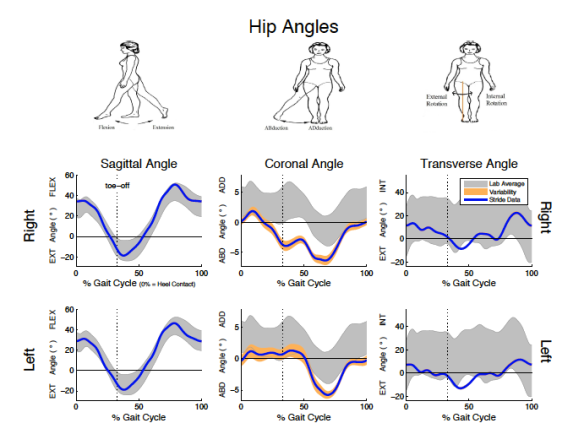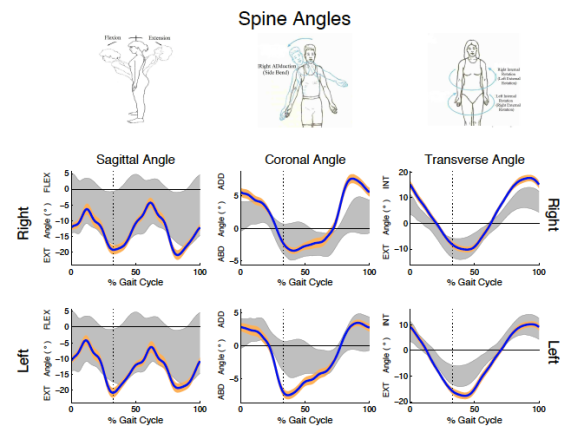 I’ve been listening to a ton of podcasts lately, and one running-related podcast I’ve enjoyed is the Run to the Top podcast from Runners Connect. In a recent episode, host Tina Muir documented her second trip to the University of Virginia SPEED Clinic in Charlottesville, VA (wahoowa!). This, of course, played right into (1) my recent speed-related goals and (2) my newfound interest in body mechanics. About three-quarters through the episode, I Googled the SPEED Clinic and emailed its director, Max, to set up an appointment. Here’s a little background and what I learned from my visit…
I’ve been listening to a ton of podcasts lately, and one running-related podcast I’ve enjoyed is the Run to the Top podcast from Runners Connect. In a recent episode, host Tina Muir documented her second trip to the University of Virginia SPEED Clinic in Charlottesville, VA (wahoowa!). This, of course, played right into (1) my recent speed-related goals and (2) my newfound interest in body mechanics. About three-quarters through the episode, I Googled the SPEED Clinic and emailed its director, Max, to set up an appointment. Here’s a little background and what I learned from my visit…
What is the UVA SPEED Clinic?
The SPEED (Strength, Power, Endurance, Education, and Development) Clinic is part of the University of Virginia School of Medicine in my former home Charlottesville, Virginia (about 2.5 hrs from DC). The director of the clinic is Max Prokopy M. Ed., CSCS, who got his master’s degree in exercise physiology from UVA and worked under the former director of the SPEED Clinic. The SPEED Clinic’s services are available to the general public, and it serves runners of all ages and abilities (it also can help golfers but that would definitely be another post). The SPEED Clinic staff performs a 3D gait analysis using state-of-the-art technology and uses that information to help runners improve efficiency and avoid injury. (The SPEED Clinic is not recommended for those in acute pain.) You can read about the clinic’s mission and method in the staff’s own words at the SPEED Clinic website.
Getting an appointment was easy: I emailed Max and he promptly replied to set up a time. I scheduled for a Friday afternoon just a few weeks after I had emailed (way faster than I had expected). Max was flexible with time and was willing to stay later than usual to accommodate my work schedule, which I really appreciated, especially on a Friday.

The clinic is in the Fontaine Research Park a couple of miles from UVA Central Grounds (i.e., don’t expect to see the Rotunda out the window.) Parking was free and easy. Check in at the administrative office and pay the $350 fee. Then one of the staff members will come meet you and take you to the clinic. Once you arrive in the clinic, the clinic staff get some basic info (weight, height) and set you up with the sensors needed for the 3D imaging. I had maybe 12 or so little sensors on my feet, ankles, knees, hips, back, chest, etc. And if you look around the clinic, you see a whole bunch of cameras to capture your movements from all angles.
Next, you move to the running portion, which happens on a funky looking green treadmill.

You run for about 8-10 minutes, including a warmup (to get used to the equipment) and then your data-gathering session. You can choose the max speed; I went with 8:30 pace since that is about my marathon pace. (Form can change with your speed, so I’d suggest getting the analysis at your long-distance pace if you are a marathoner.) After running, you do other movement tests, including some mobility and balancing tests. Next, Max walks you through your results — charts, video, and a cool 3D stick figure image. Finally, Max shows you some drills and exercises to work on at home. Admittedly, the session was a little more of a workout than I expected and my legs and abs were shaking during a few movements!
You get a thumb drive with your results — including lots of charts and videos — and with videos of the remedial exercises Max prescribes. Note that some of the features can only be viewed on PC (so this Apple devotee is going to have to find a friend to lend me theirs!). Max will also send a VERY helpful summary email and encourages you to ask questions and even to submit video via email for follow-up.
The whole assessment takes about 2.5 hours, although my session was closer to 2 hours. (Plenty of ground covered in those 2 hours!) Then I headed back to DC.

Back on the road.
Why Did I Go to the UVA SPEED Clinic?
Despite doing a lot of running over the past decade, I really have had no clue about whether I run with great form or terrible form. I know that I’ve been able to progress (but sometimes regress) in this sport with only a few injuries (some IT issues in 2009 were the most notable). But was I setting myself up for disaster down the road with my form? I’d rather identify an issue now before I end up with a tear or tendonitis or serious issues. And as I alluded to in the intro, I was hopeful that the UVA SPEED Clinic could help me shave a few minutes off my time by finding inefficiencies in my gait.
What Did I Learn at the UVA SPEED Clinic?
(1) (Let’s start with the good) I’m pretty symmetrical and I have good “compensation”! I have some pronation happening with my funky left foot but, despite that, most of my stats and charts looked similar for my right and left sides.
(2) But I have some issues. I was secretly hoping that Max was going to find some serious but easy-to-fix flaw in my running and, if I just changed that one little thing, I would magically chop off boatloads of time in my races. Perhaps that was wishful thinking, but (luckily or unluckily) Max did find some inefficiencies in my running, and he thinks if I work on them, I can save energy and get faster.
(3) I have slightly more “breaking” with each step than is ideal. Breaking necessarily happens with every step — there is a force that pushes back against us when we touch the ground. It keeps us from falling on our faces. Max said that I have a little bit more breaking than is ideal, which means that my weight is a little bit farther back than it should be when my foot touches. Not too serious. (I should note that there were several things that weren’t necessarily “ideal” about my form but since I’ve been injury free, they weren’t priorities for Max.)
(4) I sit into each hip when I run. OK, I didn’t actually learn this one at the SPEED Clinic. I’ve been seeing it for years in my race photos — which I never buy because they are so unflattering! I just assumed I had big hips, and this is what it looks like when a woman with big hips runs. Apparently, that’s not the case. Because I am not using my core and my glutes enough (more on that later), my body isn’t supporting itself the way it should. With each step, my weight is slumping into my hip, and it has to use more energy to launch me back up. I think I have developed this loose form with good intentions: I was trying to stay relaxed for 26.2 miles and “settle in.” Max showed me some photos of professional runners who looked relaxed but where still keeping their body supported when they ran. He did say that getting too rigid can present its own set of problems and can create energy-sapping tension, but I should work on finding a happy medium.
Let me pause here and show you some charts that came on my thumb drive. But to understand the charts, you might find this link and the image below helpful. This article also discusses “hip drop” and the importance of hip support during running.

Found this explanation on the internet!
OK, here is my set of charts showing my pelvic and hip movements when I run. Notice especially movement on the coronal plane (side tilt) and transverse plane (rotating).

Compare my blue line (orange shows variability in my movement) to the grey lab averages.

Hips Gone Wild!
(5) I’m over-rotating my upper body and have chicken wings. I thought I had fixed the chicken wing issue when I worked with a personal trainer, who was a former sprinter and made me do lots of pocket-to-ear drills. But apparently it’s crept back. Max said he wasn’t worried about me correcting my arms; they should get fixed automatically when I address my core (pun!) issues, and arms are good for balance anyway.
(6) My ribs are flaring and I am arching my back, so I am using my lower back to power my movements and wasting energy. Yikes. This was a bit of a wake up call for me because at this point it basically sounded like my entire body was moving wrong. And I thought I had a super strong core! Let’s take this in pieces since it’s so big.
- Rib Flare. I’ve heard a lot about rib flare (aka rib thrusting) on the Katy Says podcast, especially in the episode about diastasis recti (a word my husband likes to chant like a Latin monk). Katy says that rib flare is often caused by tightness in the shoulder girdle. Max thinks this is an oversimplification. And in any case, I can clearly see from the videos that my problem is that I am throwing my shoulders way back and making my chest point slightly upwards, instead of slightly downwards, when I am running. My ribs and my pelvis are not stabilized together at all but are flexing away from each other, coming together a little, then flexing back out. In addition to strengthening my core to connect and stabilize my ribs and pelvis, I can also work on leaning a little bit more forward with my upper body.
- Pelvis Movement. This goes along with the rib flare and the rotation of my shoulders; my lower body is exacerbating the flexion and rotation of my spine. (See pelvis and hip charts above.) Again, this is because my core, which is supposed to connect my ribs to my pelvis, and my glutes, which are supposed to stabilize my hips, aren’t working as well as they should.

More charts! I’m extending my spine and moving my upper body all over the place when I run!

My extending torso.
(7) It is more efficient to use my glutes, rather than my lower back. I’ve been hearing a lot lately about “activating glutes” and whether someone is running without activating theirs. Add me to the list! Because my upper body is so upright and my back is arched, I’m not only wasting energy by rotating and sinking to a hip: my power when I push off is coming from my lower back (no wonder it gets sore on long runs?) instead of my glutes. Think about pushing a big object like a wall, trying to get it to move. We instinctively lean forward and power with our legs and big glute muscles. The same idea applies to running. But that’s not what my body’s been doing.
(8) Either I’m not doing pilates correctly, or I’m not doing it enough. This was a little frustrating to hear. Despite going to pilates (or barre, but less-so these days) for an average of once a week for literally years, somehow it’s not strengthening my core sufficiently to stabilize the connection between my ribs and my pelvis. When I leave a class, I usually feel so strong and supported, so this was a huge shock. I’m going to chat with my pilates instructor about this and focus extra hard on my form during class. (And as Katy Bowman says, exercise is great to movement but what about the other 23 hrs in day? Where else can I integrate core work? (Raises standing desk…))
(9) My attempts at “good posture,” my ballet training, and my running backpack can all be contributing to my running form in a negative way.
- I am almost positive that I’ve developed my rib flare because I was trying to keep my chest proud when running. I thought it was having good posture by throwing back my shoulders. Nope.
- All those years of ballet? That’s another place I probably learned to flare my ribs. This is a common way that dancers try to have good presence. It isn’t technically correct, but it probably often goes uncorrected. (Max said that dancers and gymnasts can have some of the worst body mechanics.)
- It’s OK to run with a backpack, Max said, but I shouldn’t allow it to train me to jut out my chest and push back my shoulders. He also suggested I try running with a half-filled water bottle in the pack; if I hear a lot of sloshing, I’m probably moving my upper body all over the place unnecessarily.
(10) A set of deadlifts should be no more than five reps, and the weight should at least be my body weight. I LOVE deadlifts, but apparently I’ve been using way too little weight. Finally, an easy-to-implement tip!
Max gave me several other movements to do besides heavy-weight-deadlifts and I really am going to try to integrate them into my routine. Max also suggested that I check in with my body once in a while during my runs to see what my form is doing. I doubt I’ll be able to go out on day one and magically fix everything, but slowly I hope to improve.
For more info on the SPEED Clinic, check out Tina Muir’s blog post, the Run to the Top podcast, or the SPEED Clinic website.
And please feel free to ask questions in the comments below! Has anyone out there dealt with these gait issues or worked on correcting them? I’d love to hear stories from the trenches or just commiserate!

Pingback: Last Week of Asheville Marathon Training | athlettuce
Pingback: Body Fat Measurement with Composition ID | athlettuce
Pingback: Asheville Marathon 2016 Recap and Review (Marathon 16, State 11 — North Carolina) | athlettuce
Pingback: AVL Marathon and 30-Day Challenge Check In | athlettuce
Pingback: Product Review: Vivobarefoot Evo Pure shoes | athlettuce
I’m totally new to your blog and found you through Hungry Twenties…I’m so glad she linked to you because this is all *so* interesting! I think I may have the same problem of sitting into my hips when I run so I’ll have to look into that.
I do have a question though…you said Max told you a set of deadlifts should be no more than 5 lifts. Did he give you a reason? My higher reps 3/4/5 are all more than my body weight, but I usually lift in a 3-3-10 or 5-5-10 pattern and my 10 set is always less than my body weight. I’m just curious what the reasoning is behind his advice.
Thanks! I love your blog and I’ll definitely keep reading 🙂
LikeLike
First off, WELCOME! And thanks for the kind words. I think the hip-sit is a pretty common problem and the key is to strengthen the supporting glute muscles. I thought my glutes were pretty strong but I guess not (or at least not in the right spots). I think Max was saying that I should be lifting so much weight during my deadlifts that I can only do 5. So maybe if you can get to 10 reps with your heaviest weight, it is time to increase. I was grabbing a 60 lb bar and doing like reps of 12 — which was really not too strenous– and his point was that my heavy deadlift weight shouldn’t be that easy. Hope that helps!
LikeLike
Ahh okay, gotcha. I definitely cannot do 10 reps with my heaviest weight! In that case, what he said makes total sense: Low reps, high weight! It’s one of the philosophies I live by 😉
LikeLike
Pingback: First Week of VCM Training | athlettuce
Pingback: Results Are In! My 28-Day Challenge with Composition ID | athlettuce
Pingback: Goals and Race Schedule for 2017 | athlettuce
Pingback: Year in Review 2016 | athlettuce
Pingback: This is Your Brain On BQ: What Went Through My Mind at the Phoenix Marathon | athlettuce
Pingback: How to BQ: Pacing and Nutrition | athlettuce